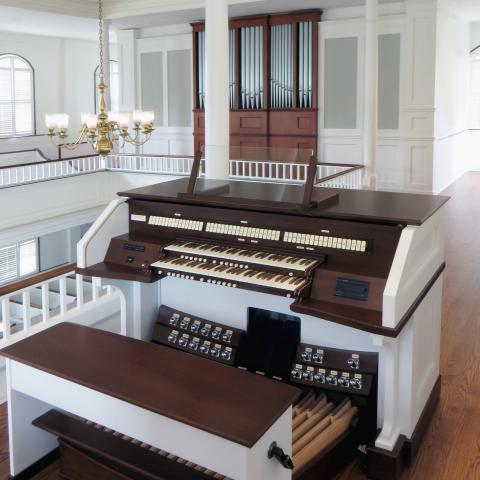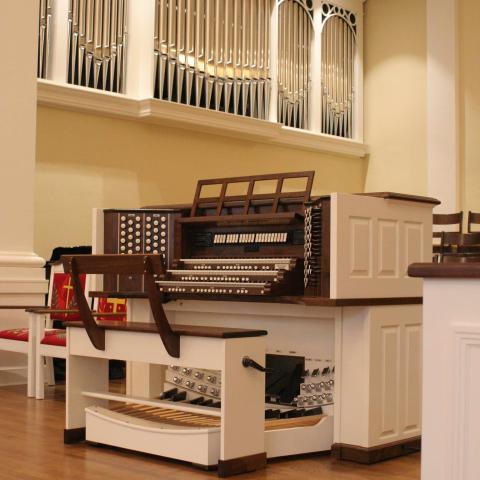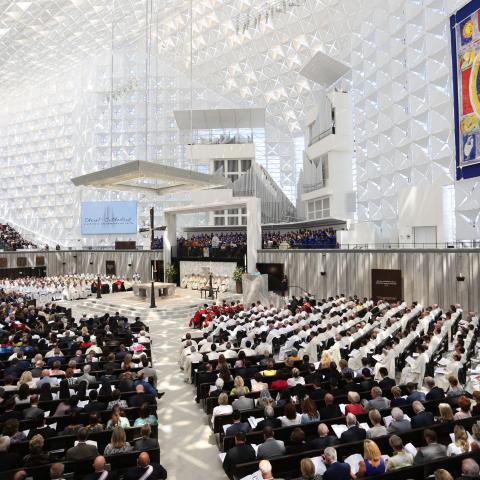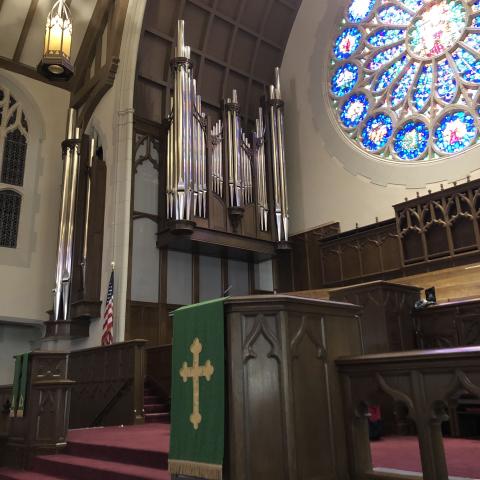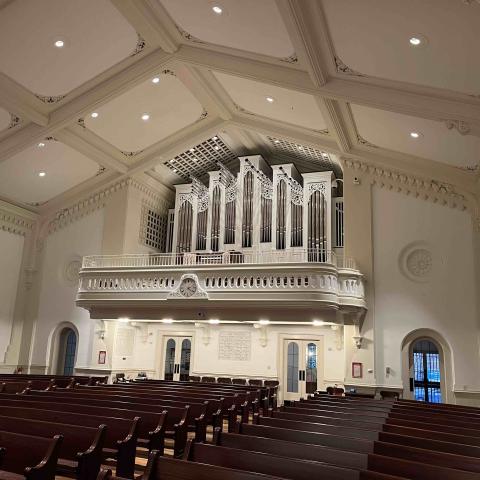Sebastian M. Glück, New York, New York; The William and Alice Stack Cathedral Organ, The Cathedral of Christ the King, Superior, Wisconsin

Sebastian M. Glück, New York, New York
The William and Alice Stack Cathedral Organ
The Cathedral of Christ the King, Superior, Wisconsin
Ground was broken for the Cathedral of Christ the King on June 23, 1926, and the building was dedicated on Christmas Day of 1927. Elegant simplicity marks the neo-Romanesque structure and its campanile, built upon a raised platform and standing nobly against the Wisconsin sky. Romanesque architecture, which features thick masonry walls with small windows rather than large expanses of flexible stained glass, normally would provide ample reverberation and the preservation of most frequencies. The cathedral’s interior stood unfinished until a fund drive was initiated in 1937 to complete the decorations and furnishings, installing carpet in the sanctuary and sound-absorbing materials covering the ceiling and the upper side and rear walls of the nave. Despite the great cubic volume of the building, reverberation was annihilated, with a range of .94 to 1.0 seconds. The choir sang from a low-ceilinged gallery above the narthex, its voices struggling to reach the crossing with the inadequate accompaniment of a small organ with failing digital stops.
A new acoustic
In 2003, Rev. Richard Vosko was engaged as the liturgical designer, along with architect Robert Semborski of Architectural Resources, Inc., of Duluth, Minnesota, to begin a revision of the cathedral, with Scott R. Riedel & Associates, Ltd. of Milwaukee, Wisconsin, as acoustic and organ consultants. The choir was relocated into the Epistle-side transept, and the altar, ambo, and liturgical functions onto a raised sanctuary space that extends into the crossing. The project was completed and dedicated in February of 2005.
The installation of terrazzo paving and the removal of the sound absorbing ceiling and side wall treatments were initial steps toward doubling the reverberation time. A coffered, hard plaster ceiling and hard surface clerestory walls now result in clear, intelligible speech and more than two seconds of gracious reverberation. Modest amounts of sound absorbing treatment on the rear wall prevent unwanted reflections and repetitions.
Upper-level balconies and ambulatory spaces flanking the sanctuary were redesigned as organ chambers for a future instrument, and the building was outfitted with electrical conduits and ductwork in anticipation of the installation of a new organ. The former hybrid organ was sold, and the cathedral used a piano as their primary musical instrument after the building renovation.
In 2003 the Cathedral Organ Committee had selected another organbuilder to build a new organ, but the price of the large instrument was formidable. The project was set aside until Scott Riedel recommended that I review the circumstances, since he had served as the consultant on three organs I had built across the country and believed that a different approach would lead to success. Client, consultant, and builder were in agreement that if an appropriate heritage organ could be adapted to the situation, the timeline could be compressed and the budget reduced. I made it very clear that despite the prevailing hopeful mythology, a complete restoration or reconfiguration of an existing organ might equal or exceed the cost of a new one.
Over a period of years, I located and offered three possibilities to the cathedral. The first was a late Frank Roosevelt organ that I had purchased and stored before its abandoned home was razed. Future plans had not been finalized in Superior, so I incorporated that instrument into a 62-rank double organ for another client (see The Diapason cover feature, April 2018). Two substantial, serially altered Aeolian-Skinner organs subsequently were brought under consideration. Both of those situations were so heavily freighted with bureaucracy, politics, and interference by middlemen that a choice was made to redirect the search.
On another front, unforeseen circumstances made the cathedral organ project possible. A church in the northeast had purchased, under my direction, carefully selected ranks from organs that had been dismantled and placed on the open market. That client chose to wait patiently for the time when they could build the organ I had designed for them without preparing any stops for future installation. At the point of signing a contract, Hurricane Sandy severely damaged that congregation’s roof, existing organ, and organ chamber. Their pipe organ would have to wait until they restored their building, and the pipes remained in storage. An evaluation of the needs of both potential clients led to the sale of that pipework to the Cathedral of Christ the King.
The available ranks were suited to adaptation for an organ in the cathedral, with adjustments to the specification, some rescaling of the fluework, and the construction of some new pipes. The clear mission was to serve the Catholic liturgy, congregational singing, and the established organ and choral literature. There was no interest in adopting the whims of any particular temporary organbuilding trend that might prove regrettable in the future. The specifications were built upon the features held in common by the instruments of the important eras and cultures of organ composition and building. That information was filtered through the registration guidelines handed down by tradition, performance practice treatises, and the composers’ scores. Such tenets distilled the stoplist toward a practical design that endures rather than frustrates.
The musical blueprint
What began as a two-manual design grew to three manuals in light of how much substantive literature called for a third, and how the nuances of choral accompaniment could be expanded. During the century and a half that Americans have placed Choir divisions under expression, these sections often have been of nebulous conception and could not serve the literature. I walked the conservative path of an unenclosed eight-rank Positiv division in the Gospel case, with the Great in the Epistle case. These divisions enjoy the spatial separation of a Baroque Positiv in a dorsal case while keeping the organ entirely on one level for the sake of tuning stability. The interior of the organ features abundant lighting, broad walkboards, sturdy tuning perches, and secure ladders to facilitate its future care and longevity.
Pipe organs of moderate size can exhibit some predictability in tonal design if the builder is a conscientious steward of a client’s funds; each indulgent frill that supplants a requisite voice is an extravagant waste—a disservice to music, liturgy, and education. Instruments of this size can be conceived with measured additions to the safety of the template, increasing color and utility without being irresponsible. My ethical obligation to keep the instrument free of artificially generated voices served to focus the stoplist and curb tonal temptation.
The forthright core of the Great division is its Diapason chorus, with the bottom octave of the 8′ standing in the speaking façade. The large scale 8′ Harmonic Flute, which takes its lowest nine pipes from the Open Diapason to maintain open tone throughout the compass, is joined by the 16′/8′ wooden Bourdon unit and the Viole de Gambe borrowed from the Swell. The 4′ Spire Flute is voiced and finished such that it can be used in unconventional combinations with other flue stops for a variety of tonal colors. The firm and round Trumpet is an extension of the Pedal reed unit, and although a theoretical compromise, is not detected as such by the listener in the now-sumptuous acoustic.
The Swell division is located in the triforium of the Epistle side of the sanctuary, with shutter fronts opening into the sanctuary as well as to the transept behind the Great windchest. This second set of shutters prevents the Swell from sounding distant and directs its tone toward the choir stalls in the transept. The division is planted on a slider soundboard like the rest of the organ, with the exception of the reeds and the Viole de Gambe, which stand on an electropneumatic unit windchest.
The American Swell division, for decades gutted of its 8′ Open Diapason, is enjoying a return of this valuable pitch base. It is included here as a hearty slotted version that is immeasurably useful in the liturgy as well as in the performance of organ and choral music. The Swell Diapason chorus is marked by a brighter Mixture than that of the Great, and although it contains only three ranks, it bears two unisons and one quint throughout the playing range to maintain clarity in voice leading. Incisive French strings of slotted construction take their traditional places, and the undulant makes a good pair with the Diapason as well. The parent rank stands behind the shutter front near the Great windchest, as it is borrowed onto the Great to complete the quartet of stops for the fonds d’huit.
The choir of flutes includes the elements of the Cornet Composé. With only one tierce combination in the instrument, I felt that the mutations should be flute scaled. Principal scaled mutations cannot weld into a Cornet, yet the 8′-22⁄3′-13⁄5′ flute combination can, in a good acoustic, convince one that there is a Sesquialtera present. This places the Cornet in a position to enter into dialogue with the half-length cylindrical reed in the Positiv while still contributing to the Grand-Jeu.
The original plan called for independent ranks for the 16′ Bassoon and 8′ Oboe, but they were reconceived as a unit when the organ was expanded to three manuals. An unexpected feature of the capped, full-length 16′ Bassoon is that when drawn in the Pedal by duplex action, it sits beautifully beneath the strings, as a surrogate Violone, and adds color and pitch identity to the Pedal line in softer combinations.
The Positiv borrows a bit from the Georgian chamber organ and a bit from the Continental Baroque, but is neither. Open flue stops at 8′ pitch were common practice for the secondary manual divisions of Bach’s time and culture. The chronic omission of such tone, as well as the frequent absence of the 4′ Principal during the Orgelbewegung’s American manifestation, perpetuated an imbalance between the Great and Positiv. The utility of the 8′ Dulciana cannot be overstated, especially when it leans more toward an Echo Diapason than the type of neutered, bland string placed in American organs of a century ago. The two-rank mixture is not high-pitched, as the Positiv differentiates itself by its weight and texture without having the upperwork separate from the ensemble. The 8′ Clarinet is made of very hard black zinc and is notably bold and broad in tone, voiced brightly so as to work well in both French organ repertoire and its characteristic soli in English anthem accompaniments. The Herald Trumpet, which plays from this manual, is placed in the triforium on the Gospel side of the sanctuary and is the most brilliant stop in the organ.
The Pedal division is derived from four boldly scaled unit ranks and carefully selected mezzo-forte stops either borrowed or extended from the manual divisions, with the 8′ Principal in the Gospel façade. The 16′ Dulciana, extended from the Positiv, is worth its weight in gold for its utility and elegance, and allows for the forcefulness of the 16′ Open Wood Bass to fully undergird the ensemble. The 16′ Trombone unit, despite its brassy flair, is warm and round, and rolls down the nave dramatically. It is scaled and voiced for the Pedal, rather than being a conceptual extension of the Great Trumpet, a practice which can lead to inadequate support in the bass.
The visual element
It is a challenge to be invited to design and build an organ after another builder’s recommended alterations have been made to the edifice. A freestanding organ in a resonant case, recessed slightly into one of the transepts, would have been ideal, but two factors negated that possibility. Reinforced concrete platforms projecting into each transept were already in place at the direction of the previously selected builder. Worshippers and visitors to the cathedral had been looking at those empty shelves and gaping holes in the transept walls for a decade and a half, and expected a resolution. In addition, three fine mosaics in the Byzantine style had been commissioned for each of the building’s apses, and their beauty had to remain in view.
My series of concept sketches began with a sculptural “pipes in the open” array, which quickly revealed itself to be contextually inappropriate. As a preservation architect attuned to precedent and context, I felt that the mid-20th-century treatment was an evasion of artistic responsibility, so I moved forward by cataloguing the building’s architectural elements. One principle of fine interior design is that if stylistically disparate furnishings are placed in a room, the gesture is most successful when they are at least two historical periods apart.
The cathedral case design, as built, combines pendant pairs of pipe stockades with wooden casework. The former is a nod to what Midwestern American builders were producing for Catholic churches at the time the cathedral was built, and the latter was inspired by my walk-through of the permanent stage settings of Palladio’s Teatro Olimpico of 1585, in which he used classical architectural elements in forced perspective to create the illusion of greater height and depth in the built environment. Unconventional as this treatment may be, one has the sense that the portions of the instrument that flank the liturgical focus of the building were always in place and meant to be there. Rather than being imposed distractions, they tend to sweep the eye back toward the sanctuary.
Beyond the walls
When a church or synagogue asks its membership to contribute funds toward a major project, the campaign is most successful if it enhances the lives of those beyond the circle of donors. If pipe organs are heard only during religious services and are kept under lock and key at all other times, a barrier is erected between the institution and the inquisitive listener. The organ is one of many tools that can bring the surrounding community into the congregation’s sphere of ministry.
The area’s organists and academics have taken note of this instrument in part because it offers a new perspective on the performance of the post-Mendelssohnian organ repertoire without rejecting any of the structure of the golden age of the organ. In a region that until recently has favored the interpretive neoclassicism of the last century, organ students are welcomed to a new pipe organ of a more inclusive academic style.
Large-scale choral works and the hundreds of pieces written for organ with solo instruments or orchestra will be more authentically experienced in this peaceful, spiritual, resonant space. The Duluth Superior Symphony Orchestra, Twin Ports Wind Orchestra, Lake Superior Chamber Orchestra, Duluth-Superior Symphony Chorus, Superior Diocesan Chorale, and myriad collegiate ensembles have a new resource through which to expand and vitalize the musical life of the region.
—Sebastian Glück
Personnel:
Sebastian M. Glück, Artistic and Tonal Director
Albert Jensen-Moulton, General Manager
Robert Ahlborg
Joseph DiSalle
Keith Goss
Dominic Inferrera
John Kawa
Robert Rast
William Wildenberg
David Winek
Suppliers:
Organ Supply Industries, A. R. Schopp’s Sons, Syndyne, Peterson Electro-Musical Products
GREAT – Manual II
16′ Bourdon (ext 8′) 12 pipes
8′ Open Diapason 58 pipes
8′ Bourdon 58 pipes
8′ Harmonic Flute (a) 49 pipes
8′ Viole de Gambe Swell
4′ Principal 58 pipes
4′ Spire Flute 58 pipes
2′ Fifteenth 58 pipes
Chorus Mixture IV 232 pipes
8′ Trumpet (b) 14 pipes
Tremulant
8′ Clarinet Positiv
8′ Herald Trumpet Positiv
Great Silent
SWELL – Manual III – enclosed
8′ Open Diapason 58 pipes
8′ Stopped Diapason 58 pipes
8′ Viole de Gambe 58 pipes
8′ Voix Céleste (TC) 46 pipes
4′ Principal 58 pipes
4′ Harmonic Flute 58 pipes
22⁄3′ Nazard 58 pipes
2′ Quarte de Nazard 58 pipes
13⁄5′ Tierce 58 pipes
Mixture III 174 pipes
16′ Bassoon (ext 8′) 12 pipes
8′ Trumpet 58 pipes
8′ Oboe 58 pipes
Tremulant
16′ Swell to Swell
4′ Swell to Swell
POSITIV – Manual I
8′ Viole de Gambe Swell
8′ Dulciana 58 pipes
8′ Holzgedeckt 58 pipes
4′ Principal 58 pipes
4′ Chimney Flute 58 pipes
2′ Recorder 58 pipes
Sharp Mixture II 116 pipes
8′ Clarinet 58 pipes
Tremulant
8′ Trumpet Great
8′ Oboe Swell
16′ Herald Trumpet (fr 8′)
8′ Herald Trumpet 58 pipes
Positiv Silent
PEDAL
32′ Untersatz (c)
16′ Open Wood Bass 32 pipes
16′ Dulciana (ext Pos 8′) 12 pipes
16′ Sub Bass 32 pipes
16′ Bourdon Great
8′ Principal 32 pipes
8′ Sub Bass (ext 16′) 12 pipes
8′ Viola Swell
8′ Dulciana Positiv
8′ Bourdon Great
4′ Fifteenth (ext 8′) 12 pipes
4′ Flute Great
16′ Trombone 32 pipes
16′ Bassoon Swell
8′ Trumpet (ext 16′) 12 pipes
8′ Bassoon Swell
4′ Clarion (ext 16′) 12 pipes
4′ Clarinet Positiv
8′ Great to Pedal
8′ Swell to Pedal
4′ Swell to Pedal
8′ Positiv to Pedal
16′ Swell to Great
8′ Swell to Great
4′ Swell to Great
8′ Positiv to Great
8′ Swell to Positiv
Great/Positiv Transfer
(a) C1–G#9 from 8′ Open Diapason
(b) extension of Pedal Trombone unit
(c) C1–B12 resultant from Open Wood Bass
Three manuals, 37 ranks, 2,107 pipes
Positiv Sharp Mixture II
C1 19.22
C25 15.19
F#31 12.15
A46 08.15
Swell Mixture III
C1 15.19.22
C13 12.15.22
C37 08.12.15
C49 01.08.12
Great Chorus Mixture IV
C1 19.22.26.29
C13 15.19.22.26
G#33 12.15.19.22
F#43 08.12.15.19
C#51 05.08.12.15
Builder’s website: www.gluckpipeorgans.com
Cathedral website: https://superiorcathedral.org
Photo by John Kawa.

